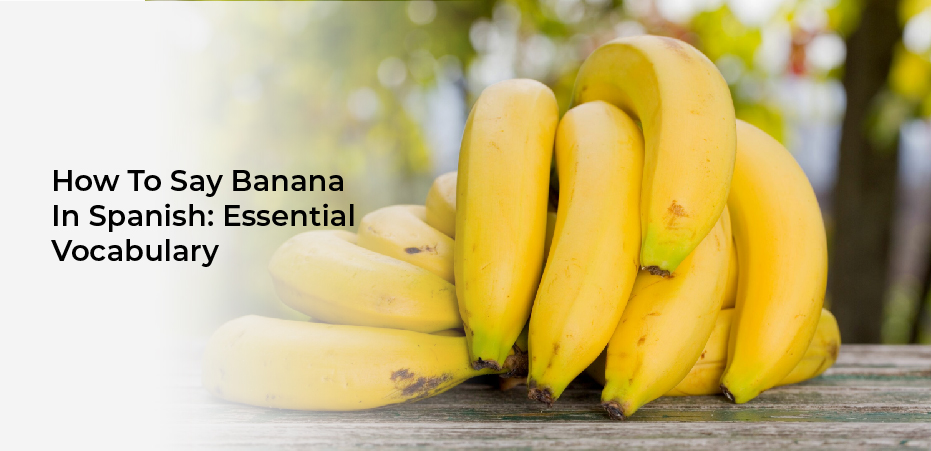Are you planning a trip to a Spanish-speaking country?
Or maybe you just want to expand your vocabulary in another language?
Either way, learning basic fruit vocabulary in Spanish is a great place to start.
And what better fruit to start with than the ever-popular banana?
Knowing how to say banana in Spanish is not only practical, but it can also open up a world of conversation and cultural understanding.
In this article, we’ll cover everything you need to know about the word banana in Spanish.
You’ll learn the correct pronunciation, different ways to use the word, and even some fun phrases and synonyms.
By the end of this article, you’ll be able to confidently use the word banana in any Spanish-speaking context.
So, let’s get started!
Learning Basic Fruits Vocabulary in Spanish
If you’re looking to expand your Spanish vocabulary, you’ll definitely want to learn how to say basic fruits like ‘banana’- it’s easy, just say ‘plátano’!
Learning basic fruits vocabulary in Spanish is essential if you want to communicate effectively with native speakers. Not only will it help you order fruits in a market, but it will also help you understand menus and recipes.
Some other basic fruits in Spanish include ‘manzana’ (apple), ‘naranja’ (orange), ‘fresa’ (strawberry), and ‘piña’ (pineapple).
It’s important to learn the correct pronunciation of these words, as some may have a different stress or accent mark than in English. With a little practice, you’ll be able to confidently order your favorite fruits in Spanish.
Pronunciation of Banana in Spanish
You’ll sound like a native speaker when you pronounce the word ‘plátano’ with the emphasis on the second syllable. In Spanish, the ‘a’ sounds like the ‘a’ in ‘father,’ so it’s pronounced ‘plah-TAH-noh.’ Remember to roll your ‘r’s when you say it, too.
It’s important to note that in some Latin American countries, ‘banano’ is used instead of ‘plátano.’ The pronunciation is the same, but it’s always good to be aware of regional differences in vocabulary.
Keep practicing your pronunciation and soon enough, you’ll be ordering a banana smoothie with ease!
Different Ways to Use the Word Banana in Spanish
Hey, have you ever wondered about the various ways to use the word for that delicious yellow fruit in Spanish? Well, there are actually quite a few ways to incorporate the word ‘banana’ into your Spanish vocabulary!
One way is to use it as a noun, just like in English. You can say ‘quiero una banana’ (I want a banana) or ‘las bananas están maduras’ (the bananas are ripe).
Another way to use it is as an adjective, such as ‘un batido de banana’ (a banana smoothie) or ‘una torta de banana’ (a banana cake).
And if you’re feeling creative, you can even use the verb form ‘bananear’ to describe someone who is acting silly or foolish, like ‘estás bananeando’ (you’re acting like a banana).
So don’t be afraid to play around with this versatile word in your Spanish conversations!
Exploring Synonyms for Banana in Spanish
Exploring different synonyms for the delicious yellow fruit in Spanish can add some spice to your conversations. While ‘plátano’ is the most common way to say ‘banana’ in Spanish, there are a number of other words that you can use to describe this fruit.
For example, ‘banano’ is a word widely used in Colombia and Central America to describe bananas. ‘Cambur’ is used in Venezuela, and ‘guineo’ is used in Puerto Rico and the Dominican Republic.
Knowing some of these different words for banana can not only make your conversations more interesting, but it can also help you to better understand the different dialects and cultures throughout the Spanish-speaking world.
Fun Phrases with the Word Banana in Spanish
Picture yourself in a lively conversation with a Spanish-speaking friend, spicing things up by throwing in some fun phrases with the word ‘plátano’, ‘banano’, ‘cambur’, or ‘guineo’.
Did you know that in some Latin American countries, the word ‘plátano’ is also used to refer to a plantain, which is a type of banana that’s usually cooked? So if you’re feeling adventurous, you can tease your friend by saying, “Me gusta el plátano maduro, pero no tanto como tú”(I like plantains when they’re ripe, but not as much as you).
Another fun phrase that you can use is “Eres mi plátano maduro”(You’re my ripe banana), which is a playful way of telling someone that you find them attractive.
And if you want to express your love for bananas in general, you can say, “El plátano es mi fruta favorita, ¡me encanta su sabor!”(Bananas are my favorite fruit, I love their taste!).
So go ahead and have fun with these phrases, and who knows, you might even impress your Spanish-speaking friend with your creativity!
Frequently Asked Questions
What are some other common fruits in Spanish besides banana?
“You’re interested in other common fruits in Spanish, right? Well, there are plenty! For example, you have manzanas (apples), naranjas (oranges), piñas (pineapples), and fresas (strawberries), just to name a few.” ‘Each region of Spain also has its own unique varieties of fruits that are worth trying if you get the chance.’
How do you say “banana peel”in Spanish?
To say “banana peel”in Spanish, you would use the phrase “cáscara de plátano”. It’s important to know this term when discussing the uses and benefits of bananas in Spanish-speaking countries.
Are there any regional variations in the way banana is pronounced in Spanish?
You may notice some regional variations in the way banana is pronounced in Spanish. For example, in some parts of Latin America, it’s pronounced as “plátano,”while in Spain, it’s pronounced as “banana.”
Can you provide some examples of idioms or expressions in Spanish that use the word “banana”?
You can expand your Spanish vocabulary by learning idioms and expressions that use the word “banana”. For example, “estar como una banana”means to be embarrassed, and “llevarse el gato al agua”is a way to say you’ve won something.
What are some common recipes or dishes in Spanish cuisine that use bananas?
You can try making plátanos maduros, a popular dish in Spanish cuisine. Simply fry ripe bananas until they are caramelized and serve as a side dish or dessert. Another option is to use bananas in a tropical fruit salad.
Conclusion
So there you have it, amigo! You now know how to say ‘banana’ in Spanish and have expanded your vocabulary with other fruit names and phrases.
Keep practicing your pronunciation and try using these words in conversation with native speakers to improve your skills.
Remember that learning a new language can be challenging, but it’s also an incredibly rewarding experience. Don’t be afraid to make mistakes and keep pushing yourself to learn more.
With dedication and practice, you’ll soon be speaking Spanish like a pro. ¡Buena suerte! (Good luck!) ¡No te rindas! (Don’t give up!)


